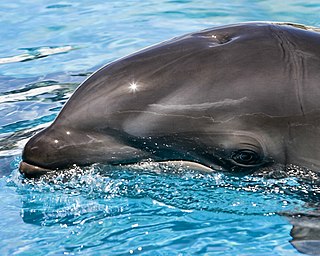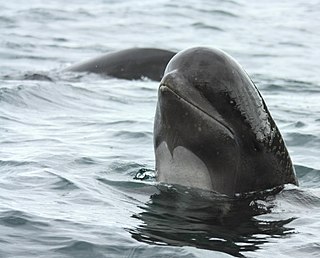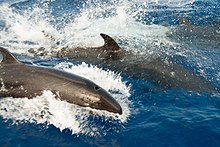Blackfish is a common name for various species of fishes and cetaceans, including:

A wholphin(portmanteau of whale and dolphin) is an extremely rare cetacean hybrid born from a mating of a female common bottlenose dolphin with a male false killer whale. The name implies a hybrid of whale and dolphin, though taxonomically, both are in the oceanic dolphin family, which is in the toothed whale clade. This type of hybrid was considered unexpected given the sometimes extreme size difference between a female common bottlenose dolphin and a male false killer whale. Wholphins have been born in captivity and have also been reported in the wild.

The false killer whale is a species of oceanic dolphin that is the only extant representative of the genus Pseudorca. It is found in oceans worldwide but mainly in tropical regions. It was first described in 1846 as a species of porpoise based on a skull, which was revised when the first carcasses were observed in 1861. The name "false killer whale" comes from having a skull similar to the orca, or killer whale.
P. crassidens may refer to:

Orcinus citoniensis is an extinct species of orca identified in the Late Pliocene of Italy and the Early Pleistocene of England. It was smaller than the modern killer whale, 4 m (13 ft) versus 7 to 10 m, and had around 8 more teeth in its jaw. It may have resembled the modern killer whale in appearance, and could represent a transitional species between the modern killer whale and other dolphins. O. citoniensis could have hunted fish and squid in pods, and coexisted with other large predators of the time such as the orcinine Hemisyntrachelus and the extinct shark Otodus megalodon.

Orcinus paleorca is a fossil species of Orcinus, the genus of killer whales (orca), dated to the Middle Pleistocene.

Globicephalinae is a subfamily of oceanic dolphins that includes the pilot whales, the pygmy killer whale, the rough-toothed dolphin, the false killer whale, the melon-headed whale, Risso's dolphin, and the snubfin dolphins.
Pseudorca yokoyamai is an extinct species of oceanic dolphin from the Calabrian stage of the Pleistocene of Japan, an extinct relative of the modern day false killer whale.





